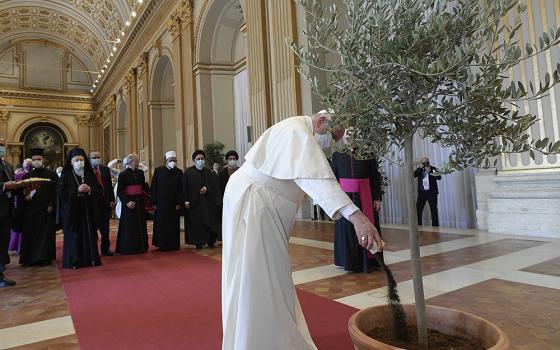Cardinal Daniel DiNardo of Galveston-Houston greets newly ordained Deacon Bruce Flagg during an ordination Mass for permanent deacons at the Co-Cathedral of the Sacred Heart in Houston Feb. 20. (CNS/Texas Catholic Herald/James Ramos)
The U.S. Catholic Church in 2020 had 18,075 permanent deacons serving in ministry, a decrease of 118 deacons, less than 1%, from the previous year, according to data collected by the Center for Applied Research in the Apostolate in Washington.
Despite the slight decline, as shown in information in the Official Catholic Directory, CARA researchers expect the number of permanent deacons to grow to a projected 19,478 based on trends since 2003.
Meanwhile, a total of 124 formation permanent diaconate formation programs in the U.S. reported 2,105 candidates enrolled during the 2020-2021 academic, a decrease of 50 candidates, about 2%, from the previous year, researchers found.
The number of permanent deacons has remained steady in recent years after steady growth with ordinations beginning in 1972. The ministry was reestablished by St. Paul VI in 1967 following the reforms of the Second Vatican Council.
CARA released a report on its findings Sept. 7. The study was completed in July.
Advertisement
A breakdown of the data collected by the center show that the share of candidates in their 30s and 40s stood at 22% in the 2020-2021 academic year. That represents a 50% decline in the share of candidates in the two youngest age groups since 2002.
Nearly half, 45% of candidates, were in their 50s and 33% were age 60 or older in the same academic year.
Canon law requires permanent deacons be at least age 35 to enter formation.
The study reported that the vast majority of candidates, 95%, were married. Another 2% were single, never married and 2% were widowed or divorced.
It appears that the diaconate is become more racially diverse. Looking at data on the racial and ethnic mix of candidates, the study found that 67% of candidates were white. In comparison, during the 2002-2003 academic year 76% of candidates were white.
Meanwhile, 26% of candidate were Hispanic or Latino. CARA projected the share of Hispanic or Latino candidates would grow to 29% in the 2025-2026 academic year.
CARA projected the share of Hispanic or Latino candidates would grow to 29% in the 2025-2026 academic year.
According to the data: 4% of diaconate candidates were Asian or Pacific Islanders, 2% were Black and 2% were Native Americans, multiracial or another ethnicity. The combined share of candidates in these ethnic groups has remained stable at 6 to 8% of formation classes since 2002-2003, the report said.
The U.S. has 159 confirmed formation programs for the permanent diaconate and an additional 15 programs are "most likely to exist," CARA said. Overall, 35 programs had no candidates in formation during the 2020-2021 academic year.
The largest formation programs exist in Texas. The Archdiocese of San Antonio reported 74 diaconate candidates while the Archdiocese of Galveston-Houston had 71 candidates.
Rounding out the top five were the Archdiocese of Los Angeles with 61 candidates, the Archdiocese of Newark, New Jersey with 54 and the Diocese of Charleston, South Carolina with 49.
The survey of formation programs found that 25% of candidates had a graduate degree and 39% had a bachelor's degree. Another 14% of candidates had some college education and 22% had a high school diploma or no diploma.





